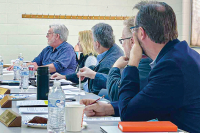Filling the flood plain under debate in Macon
 Macon County is weighing whether to relax its existing rules that ban fill dirt in the flood plain.
Macon County is weighing whether to relax its existing rules that ban fill dirt in the flood plain.
The county’s planning board is split on the issue and struggling to find mutual ground to stand on.
The five-year-old law is one of the stricter flood plain ordinances in the state. It prohibits any imported dirt from being brought in to flood plains. It was enacted following severe flooding in 2004, when two 500-year floods were witnessed along tributaries of the Little Tennessee River. The law follows the logic that the flood plain is a natural reservoir for surging storm waters. Macon County is known for its wide Little Tennessee River valley and several major creek bottoms.
Filling in the flood plain for development or construction like putting your thumb over the nozzle of a garden hose spout — the water is constricted and flows faster.
“It’s a public safety issue in our eyes,” said Bob Wright, who was chairman of the county’s Watershed Council when the law was written.
Related Items
Wright said mountain areas are better served by stricter flood laws than the rest of the state due to their topography. When rain falls on mountainsides it is soon channeled into the valleys making the area more prone to flash floods. The part of the ordinance now under fire — the “no fill” clause, as its been dubbed — applies to the county’s 100-year flood plain, the buffer around rivers that supposedly floods every 100 years.
However, that has not been the case. Macon County has had about 10 of these 100-year floods in the past 230 years or so.
“Memories are short,” Wright said. “When you talk about the 100-year flood, people say ‘what are we going to worry about something that happens every 100 years for?’”
Some have seen the inflexible law as burdensome to property owners who want to build up the ground’s elevation in flood plains. They argue a little fill dirt may not have much of a noticeable effect on water flows.
The issue first surfaced when a representative from Wells Grove Baptist Church asked if the church could use some fill dirt to expand its parking lot into the flood plain. Then, county commissioners briefly entered into panic at another meeting this spring when they feared the law would inhibit their plans to develop a $1.2 million baseball complex in the flood plain.
Planning Board Member Bill Frutal said the law is also having an undesired effect on property owners who want to build a house in the flood plain, perhaps for a view of the nearby river, yet are constrained by the law in their homebuilding options.
Frutal, who is also a general contractor, said fill dirt would permit homeowners to compact an earth foundation underneath to elevate their house and keep it drier and allow them to avoid the alternative.
“You could build a house like you see at the beach where you build it on stilts,” Frutal said.
Although Frutal said he can understand the safety concerns voiced by opponents of the changes, he believes it’s a basic property rights issue. He also said concerns about drastically changing the natural flows of county waterways are a bit overblown. The cost of extensive fill in the flood plain is a naturally a limiting factor, so he doesn’t think a change to the law will open the floodgates.
“I don’t think you’d have a bunch of people go willy nilly filling in the flood plain,” Frutal said. “It’s your property; you should be able to be able to fill.”
However, for another longtime planning board member, the issue is also a matter of property rights, but the rights of the property owners downstream. Water in the floodplain displaced by the fill dirt on one side of the river must go somewhere, most likely spilling onto someone else’s property downstream.
“It’s like putting a brick in a bucket of water,” said Planning Board Member Susan Ervin. “That water will be displaced and where it will go is to downstream properties.”
The planning board is entering its final stretch of discussion on the issue, with a recommendation for commissioners coming by the end of May or June.
But since commissioners directed the board to take up the issue months ago, the talks have garnered formidable attention from a slew stakeholders who are against any changes. From environmental advocates to safety experts to farmers, the split planning board has gotten an earful about reasons not to change the law.
One board member said he was swayed against amending the ordinance when a county farmer spoke before the board on the value of farmland, often found in the rich soil deposits left in the floodplain. Lewis Penland said the county’s river fertile farmland takes centuries to develop into grow-able conditions but all that progress can be covered in a matter of one construction project.
“When you fill it up, pave it and put a Walmart on top of it, it’s done,” Penland said. “It seems we’re so short-sighted in our thinking.”
Also, as a commercial realtor, Penland said there is a 15- to 20-year supply of commercial real estate in Macon County, so he didn’t understand the urgency to open up the flood plain for construction. Similarly, agriculture in Macon County is a $40 million per year industry, Penland said, and a change to the law could threaten the future of that industry and the county’s food supply. He said his family also has a farm in the area.
“What’s the next generation going to use to feed themselves?” Penland said. “You need a doctor or lawyer once or twice in your life, but you need a farmer three times a day.”
With strong opinions on both sides of the issue, County Planner Matt Mason is hoping some sort of compromise could be reached, allowing a certain amount of filling in the flood plain but with limitations on its purpose and extent. Any final decisions will be made by county commissioners.
Mason has his eye on a bill that recently passed the N.C. Senate that would nullify any local environmental regulations that are more strict than the state’s.
Strictly from a public safety standpoint, it may be best not to touch the law, Mason said, but he wants someone who is looking to build a modest house to have the ability to put fill underneath it.
Something in the middle may be in store, he hopes.
“I could, personally, see both sides of the argument,” Mason said. “And when you sit down and compromise, you usually have the best product.”









